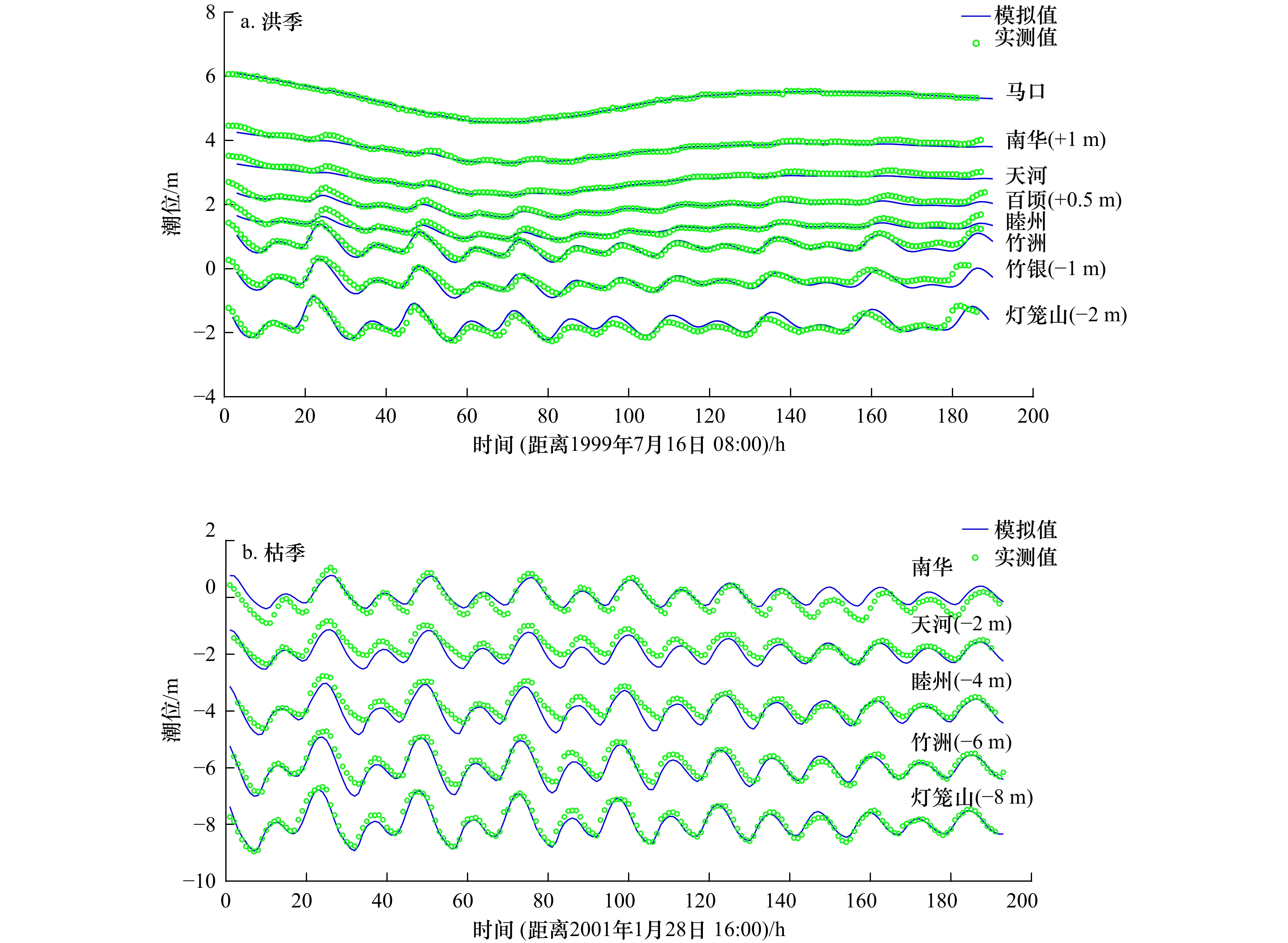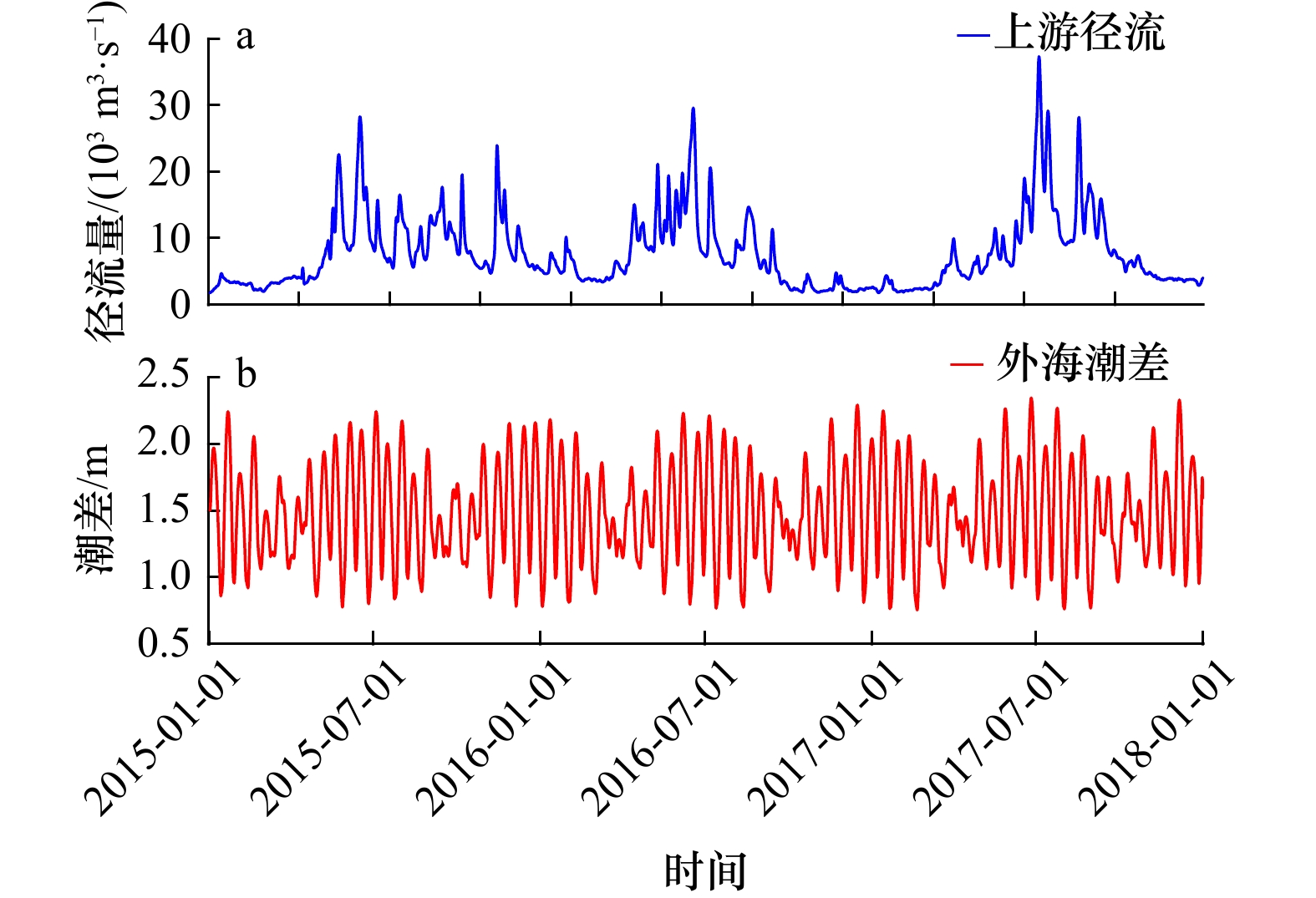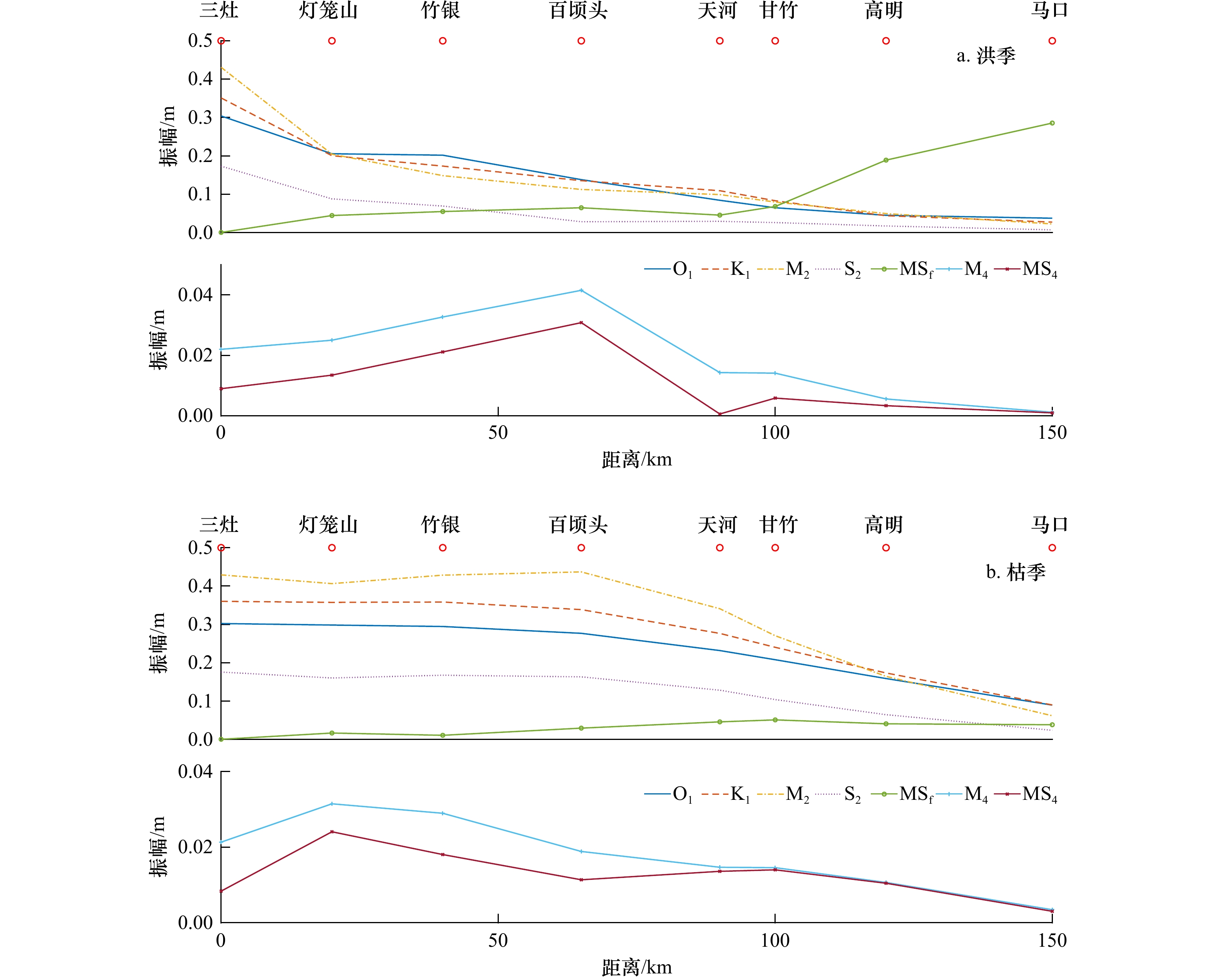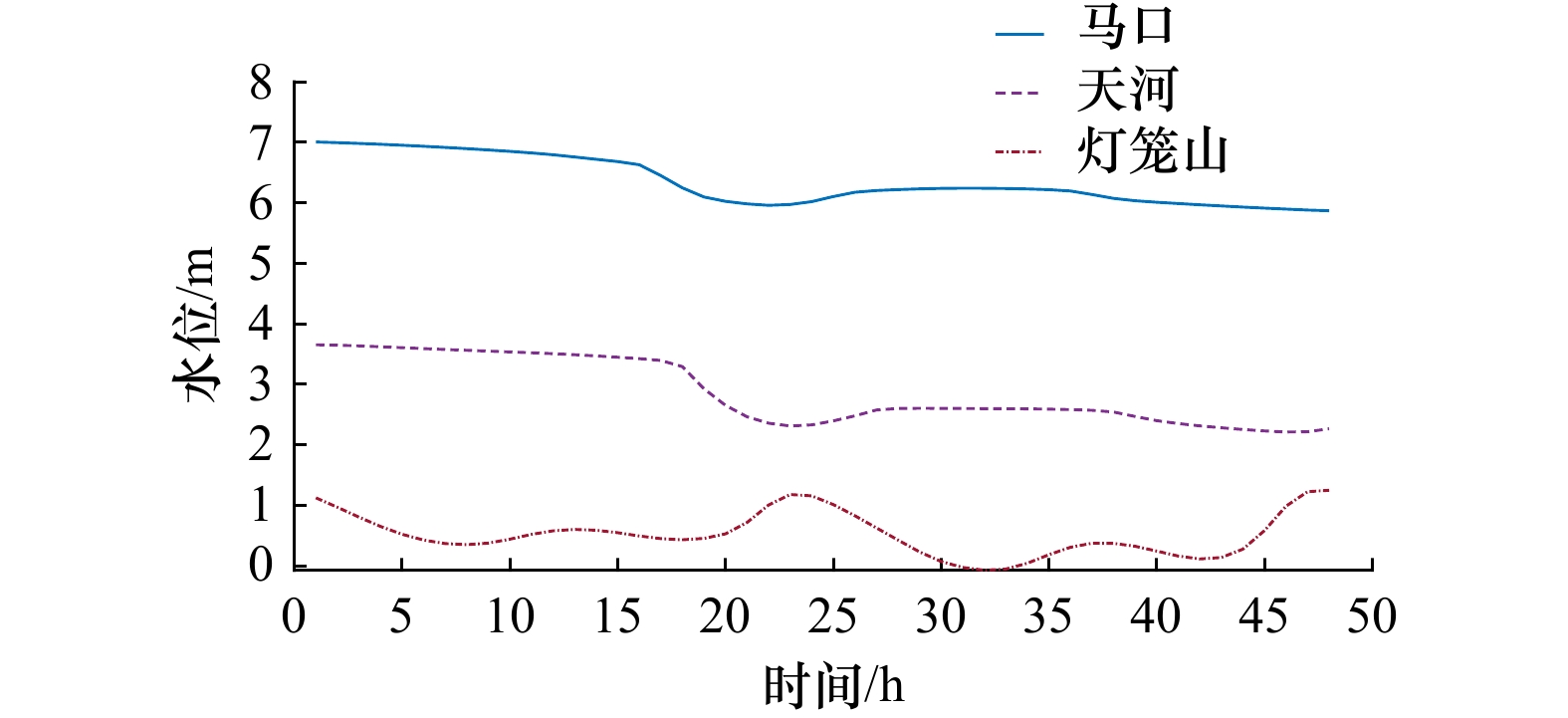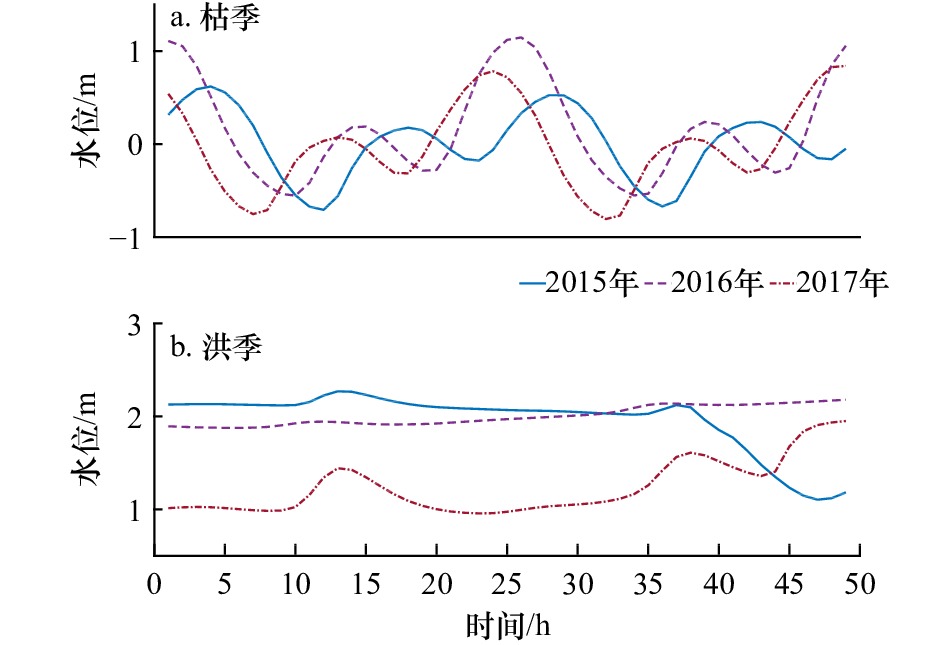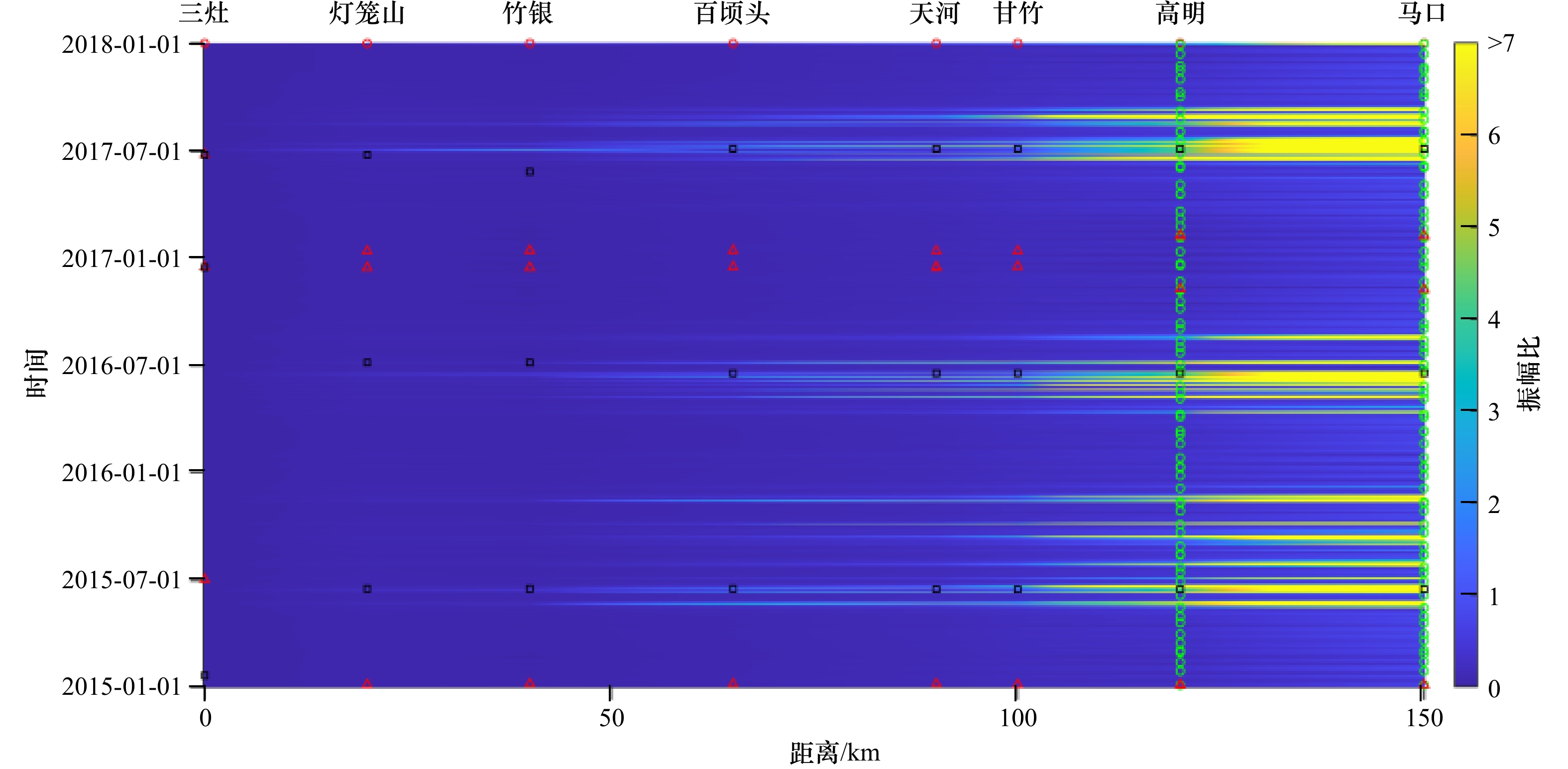Analysis of the tidal characteristics along the tidal reach of Xijiang River considering river discharge variation
-
摘要: 本文基于2015−2017年西江感潮河道的潮位数据,应用非平稳潮调和分析模型NS-TIDE,研究了不同周期分潮振幅和迟角的时空变化特征、潮汐动力构成变化和潮波变形特征,并讨论了感潮河道中的潮位变形、极低潮位颠倒等现象的形成原因。结果表明,不同于全日、半日分潮振幅的沿程衰减和迟角的沿程递增,浅水分潮振幅先增后减,MSf分潮振幅呈递增趋势、迟角有显著的增减交替变化;各个分潮的振幅洪季衰减速率大于枯季,迟角在洪季变化较大,表明径流顶托作用下的潮波向上游传播速度较慢。受径流、地形等因素的影响,在洪季和上游河段,MSf分潮振幅更大,潮汐动力由主分潮向次分潮转移,M4和M2分潮振幅比的变化表明潮汐变形显著,MSf与M2、S2分潮的振幅比较大时有最低低水位的颠倒现象。Abstract: Based on the tide level data along the tidal reach of Xijiang River from 2015 to 2017, we applied the nonstationary tidal harmonic analysis model NS-TIDE to study the spatial and temporal variation characteristics of the amplitude and phase of different cycles of tidal constituent, the change of tidal dynamics composition and tidal wave deformation characteristics, and discussed the causes of tidal level deformation and the reversal of the lowest low waters along the tidal reach. The results show that, unlike the diurnal constituent and semi-diurnal constituent along the tidal reach that have amplitude decay and phase increment, the shallow water component amplitude increases and then decreases, the amplitude of MSf is increasing, and the phase is changing alternately; the decay rate of each tidal amplitude is higher in the flood season than in the dry season, and the phase changes more in the flood season, indicating that the tidal wave propagates upstream more slowly under the top support of river discharge. Due to the influence of river discharge and topography, the amplitude of MSf is larger in the flood season and upstream section of the river, and the tidal dynamic composition changes from the main tidal constituent to the secondary tidal constituent; the change of amplitude ratio of M4 and M2 indicates significant tidal deformation, and the reversal of the lowest low waters when the amplitude ratio of MSf to M2 and S2 is relatively large.
-
表 1 2015−2017年西江感潮河道沿程各站潮位均方根误差(RMSE)
Tab. 1 Root mean square error (RMSE) of tide level at each station along the tide reach of Xijiang River from 2015 to 2017
测站 实验一:指定分潮+0.1 实验二:不指定分潮+0.1 实验三:不指定分潮+0.15 马口 0.251 3 0.253 9 0.253 8 高明 0.184 9 0.188 7 0.188 0 甘竹 0.150 9 0.155 7 0.153 5 天河 0.140 6 0.148 8 0.146 2 百顷头 0.110 8 0.131 3 0.131 2 竹银 0.059 6 0.111 6 0.109 0 灯笼山 0.053 1 0.106 1 0.103 8 三灶 0.017 6 0.110 3 0.110 1 表 2 2015−2017年西江感潮河道沿程各站的P1与K1和K2与S2分潮时变迟角均值对比
Tab. 2 Comparison of mean values of P1 vs. K1 and K2 vs. S2 tidal constituents time-varying tide delay angles at each station along the tide reach of Xijiang River from 2015 to 2017
测站 P1 K1 K2 S2 马口 79.793 6° 87.087 5° 134.144 1° 137.938 1° 天河 77.017 3° 65.229 6° 43.303 4° 44.614 3° 灯笼山 322.557 5° 323.680 1° 348.114 2° 332.217 0° 三灶 300.176 8° 303.870 0° 308.689 3° 299.212 0° 表 3 2015−2017年西江感潮河道沿程各站P1、K2和MSf分潮的振幅、迟角及其误差
Tab. 3 Amplitude, phase and their error of P1, K2 and MSf tidal constituents at each station along the tide reach of the Xijiang River from 2015 to 2017
测站 分潮 非稳态调和分析(取平均值) 经典调和分析 振幅/m 振幅误差/m 迟角/(°) 迟角误差/(°) 振幅/m 迟角/(°) 马口 P1 0.007 7 0.001 2 79.793 6 14.530 4 K2 0.003 6 0.000 5 134.144 1 10.005 8 MSf 0.040 4 0.016 3 236.484 7 55.229 5 天河 P1 0.056 3 0.003 4 77.017 3 5.247 2 K2 0.021 8 0.001 6 43.303 4 4.641 9 MSf 0.036 5 0.005 6 39.918 2 9.016 2 灯笼山 P1 0.099 4 0.002 2 322.557 5 1.269 9 0.101 2 322.117 7 K2 0.066 5 0.002 0 348.114 2 1.700 1 0.068 7 348.521 0 MSf 0.023 0 0.001 8 42.845 3 4.138 5 0.024 3 45.736 4 三灶 P1 0.110 8 6.044 7×10−4 300.176 8 0.345 3 0.110 5 300.384 9 K2 0.064 0 5.196 5×10−4 308.689 3 0.469 0 0.064 0 308.940 5 MSf 8.097 0×10−4 4.0736×10−4 296.694 6 61.735 1 2.2648×10−4 294.742 6 表 4 潮汐分潮周期及频率
Tab. 4 Tidal constituent period and frequency
种类 名称 周期 频率/cph 全日分潮 Q1 26.868 4 h 0.037 218 O1 25.819 3 h 0.038 731 P1 24.065 9 h 0.041 552 K1 23.934 5 h 0.041 781 半日分潮 N2 12.658 3 h 0.078 999 M2 12.420 6 h 0.080 511 S2 12.000 0 h 0.083 333 K2 11.967 2 h 0.083 561 四分之一日分潮 MN4 6.269 1 h 0.159 511 M4 6.210 3 h 0.161 023 MS4 6.103 3 h 0.163 844 六分之一日分潮 M6 4.140 2 h 0.241 534 半月分潮 MSf 14.765 3 d 0.002 822 -
[1] 徐民. 珠江八大出口潮汐特性变化浅析[J]. 广东水利水电, 2003(4): 47−49.Xu Min. Analysis on variance of tidal regime of the Pearl River estuaries[J]. Guangdong Water Resources and Hydropower, 2003(4): 47−49. [2] 肖莞生, 卢婧青, 陈国轩, 等. 珠三角八大口门潮汐调和分析及潮性特征对比[J]. 广东水利水电, 2013(5): 6−11.Xiao Guansheng, Lu Jingqing, Chen Guoxuan, et al. Analysis of tidal harmonic and comparison of tidal characteristics of eight major gateways in the Pearl River Delta[J]. Guangdong Water Resources and Hydropower, 2013(5): 6−11. [3] 袁小婷, 程和琴, 郑树伟, 等. 近期长江大通至南京河段潮动力变化趋势与机制[J]. 海洋通报, 2019, 38(5): 553−561.Yuan Xiaoting, Cheng Heqin, Zheng Shuwei, et al. A study on the trend and change mechanism of tidal dynamic at Datong-Nanjing Reach of the Changjiang River in recent years[J]. Marine Science Bulletin, 2019, 38(5): 553−561. [4] Matte P, Secretan Y, Morin J. Temporal and spatial variability of tidal-fluvial dynamics in the St. Lawrence fluvial estuary: an application of nonstationary tidal harmonic analysis[J]. Journal of Geophysical Research: Oceans, 2014, 119(9): 5724−5744. [5] Pan Haidong, Lü Xianqing, Wang Yingying, et al. Exploration of tidal-fluvial interaction in the Columbia River Estuary using S_TIDE[J]. Journal of Geophysical Research: Oceans, 2018, 123(9): 6598−6619. [6] Gallo M N, Vinzon S B. Generation of overtides and compound tides in Amazon Estuary[J]. Ocean Dynamics, 2005, 55(5/6): 441−448. [7] 路川藤. 长江口潮波传播[D]. 南京: 南京水利科学研究院, 2009.Lu Chuanteng. Tidal wave propagation in the Changjiang Estuary[D]. Nanjing: Nanjing Hydraulic Research Institute, 2009. [8] 路川藤, 罗小峰, 陈志昌. 长江口不同径流量对潮波传播的影响[J]. 人民长江, 2010, 41(12): 45−48.Lu Chuanteng, Luo Xiaofeng, Chen Zhichang. Influence of different runoffs on tidal wave propagation at Changjiang River Estuary[J]. Yangtze River, 2010, 41(12): 45−48. [9] Guo Leicheng, van der Wegen M, Jay D A, et al. River-tide dynamics: exploration of nonstationary and nonlinear tidal behavior in the Changjiang River Estuary[J]. Journal of Geophysical Research: Oceans, 2015, 120(5): 3499−3521. doi: 10.1002/2014JC010491 [10] 郭磊城, 朱春燕, 何青, 等. 长江河口潮波时空特征再分析[J]. 海洋通报, 2017, 36(6): 652−661.Guo Leicheng, Zhu Chunyan, He Qing, et al. Examination of tidal wave properties in the Changjiang River Estuary[J]. Marine Science Bulletin, 2017, 36(6): 652−661. [11] 欧素英, 杨清书. 珠江三角洲网河区径流潮流相互作用分析[J]. 海洋学报, 2004, 26(1): 125−131.Ou Suying, Yang Qingshu. Interaction of fluctuating river flow with a barotropic tide in river network of the Zhujiang Delta[J]. Haiyang Xuebao, 2004, 26(1): 125−131. [12] 欧素英, 田枫, 郭晓娟, 等. 珠江三角洲径潮相互作用下潮能的传播和衰减[J]. 海洋学报, 2016, 38(12): 1−10.Ou Suying, Tian Feng, Guo Xiaojuan, et al. Propagation and damping of tidal energy in the Pearl River Delta[J]. Haiyang Xuebao, 2016, 38(12): 1−10. [13] 欧素英, 杨清书, 杨昊, 等. 河口三角洲径流和潮汐相互作用模型及应用[J]. 热带海洋学报, 2017, 36(5): 1−8.Ou Suying, Yang Qingshu, Yang Hao, et al. The development and application of river-tide harmonic model[J]. Journal of Tropical Oceanography, 2017, 36(5): 1−8. [14] 杨昊, 欧素英, 傅林曦, 等. 珠江磨刀门河口日均水位变化及影响因子辨识[J]. 水利学报, 2020, 51(7): 869−881.Yang Hao, Ou Suying, Fu Linxi, et al. Quantifying the impacts of external forcing on daily averaged water levels in the Modaomen Estuary of the Pearl River[J]. Journal of Hydraulic Engineering, 2020, 51(7): 869−881. [15] Cai Huayang, Savenije H H G, Yang Qingshu, et al. Influence of river discharge and dredging on tidal wave propagation: Modaomen Estuary case[J]. Journal of Hydraulic Engineering, 2012, 138(10): 885−896. doi: 10.1061/(ASCE)HY.1943-7900.0000594 [16] Cao Yu, Zhang Wei, Zhu Yuliang, et al. Impact of trends in river discharge and ocean tides on water level dynamics in the Pearl River Delta[J]. Coastal Engineering, 2020, 157: 103634. doi: 10.1016/j.coastaleng.2020.103634 [17] 童朝锋, 司家林, 张蔚, 等. 伶仃洋洪季潮波传播变形及不对称性规律分析[J]. 热带海洋学报, 2020, 39(1): 36−52.Tong Chaofeng, Si Jialin, Zhang Wei, et al. Analysis of tidal wave propagation distortion and asymmetry in Lingding Bay during wet season[J]. Journal of Tropical Oceanography, 2020, 39(1): 36−52. [18] 龚文平, 刘欢, 任杰, 等. 黄茅海河口潮波的传播特征与机理研究[J]. 海洋学报, 2012, 34(3): 41−54.Gong Wenping, Liu Huan, Ren Jie, et al. The study of tidal propagation the in Huangmaohai Estuary and its underlying mechanisms[J]. Haiyang Xuebao, 2012, 34(3): 41−54. [19] 谢梅芳, 张萍, 杨昊, 等. 珠江“伶仃洋河口湾−虎门−潮汐通道”的潮波传播特征[J]. 热带海洋学报, 2021, 40(4): 1−13.Xie Meifang, Zhang Ping, Yang Hao, et al. Tidal wave propagation dynamics in Lingdingyang Bay-Humen outlet-tidal channel of the Pearl River[J]. Journal of Tropical Oceanography, 2021, 40(4): 1−13. [20] Wang Zhengbing, Jeuken C, de Vriend H J. Tidal asymmetry and residual sediment transport in estuaries[R]. [S.l. : s.n.], 1999. [21] Lu Sheng, Tong Chaofeng, Lee D Y, et al. Propagation of tidal waves up in Changjiang Estuary during the dry season[J]. Journal of Geophysical Research: Oceans, 2015, 120(9): 6445−6473. doi: 10.1002/2014JC010414 [22] Luo Xiaoya, Zhang Wei, Chen Shijia, et al. Evolution of reversal of the lowest low waters in a tidal river network[J]. Journal of Hydrology, 2020, 585: 124701. doi: 10.1016/j.jhydrol.2020.124701 [23] 武家兴, 王浩丞, 张璐, 等. 西江感潮河道(马口−磨刀门)的潮波传播特征研究[J/OL]. 热带海洋学报, 2023, 42 (4): 47-62. http://kns.cnki.net/kcms/detail/44.1500.p.20220921.0911.002.html.Wu Jiaxing, Wang Haocheng, Zhang Lu, et al. Investigation into the tidal propagation features along the tidal reach of West River (Makou-Modaomen)[J/OL]. Journal of Tropical Oceanography, 2023, 42 (4): 47-62. http://kns.cnki.net/kcms/detail/44.1500.p.20220921.0911.002.html. [24] Padman L, Erofeeva S. Tide model driver (TMD) manual[EB/OL]. (2021−11−20) [2022−11−08]. http://www.esr.org/polar_tide_models/README_TMD.pdf. [25] Matte P, Jay D A, Zaron E D. Adaptation of classical tidal harmonic analysis to nonstationary tides, with application to river tides[J]. Journal of Atmospheric and Oceanic Technology, 2013, 30(3): 569−589. doi: 10.1175/JTECH-D-12-00016.1 [26] Jay D A, Leffler K, Diefenderfer H L, et al. Tidal-fluvial and estuarine processes in the Lower Columbia River: I. Along-channel water level variations, Pacific Ocean to Bonneville dam[J]. Estuaries and Coasts, 2015, 38(2): 415−433. doi: 10.1007/s12237-014-9819-0 [27] Gan Min, Chen Yongping, Pan Shunqi, et al. A modified nonstationary tidal harmonic analysis model for the Changjiang Estuarine Tides[J]. Journal of Atmospheric and Oceanic Technology, 2019, 36(4): 513−525. doi: 10.1175/JTECH-D-18-0199.1 [28] Yu Xiayan, Zhang Wei, Hoitink A J F. Impact of river discharge seasonality change on tidal duration asymmetry in the Changjiang River Estuary[J]. Scientific Reports, 2020, 10(1): 6304. doi: 10.1038/s41598-020-62432-x [29] 吕咸青, 潘海东, 王雨哲. 潮汐调和分析方法的回顾与展望[J]. 海洋科学, 2021, 45(11): 132−143.Lü Xianqing, Pan Haidong, Wang Yuzhe. Review and prospect of tidal harmonic analysis method[J]. Marine Sciences, 2021, 45(11): 132−143. [30] Chen Yongping, Gan Min, Pan Shunqi, et al. Application of auto-regressive (AR) analysis to improve short-term prediction of water levels in the Changjiang Estuary[J]. Journal of Hydrology, 2020, 590: 125386. doi: 10.1016/j.jhydrol.2020.125386 [31] Friedrichs C T, Aubrey D G. Non-linear tidal distortion in shallow well-mixed estuaries: a synthesis[J]. Estuarine, Coastal and Shelf Science, 1988, 27(5): 521−545. doi: 10.1016/0272-7714(88)90082-0 [32] Wong L A, Chen J C, Xue Huijie, et al. A model study of the circulation in the Pearl River Estuary (PRE) and its adjacent coastal waters: 1. Simulations and comparison with observations[J]. Journal of Geophysical Research: Oceans, 2003, 108(C5): 3156. doi: 10.1029/2002JC001451 [33] Mao Qingwen, Shi Ping, Yin Kedong, et al. Tides and tidal currents in the Zhujiang River Estuary[J]. Continental Shelf Research, 2004, 24(16): 1797−1808. doi: 10.1016/j.csr.2004.06.008 [34] Hoitink A J F, Jay D A. Tidal river dynamics: implications for deltas[J]. Reviews of Geophysics, 2016, 54(1): 240−272. doi: 10.1002/2015RG000507 [35] Buschman F A, Hoitink A J F, van der Vegt M, et al. Subtidal water level variation controlled by river flow and tides[J]. Water Resources Research, 2009, 45(10): W10420. [36] Sassi M G, Hoitink A J F. River flow controls on tides and tide-mean water level profiles in a tidal freshwater river[J]. Journal of Geophysical Research: Oceans, 2013, 118(9): 4139−4151. doi: 10.1002/jgrc.20297 [37] Godin G. The propagation of tides up rivers with special considerations on the Upper Saint Lawrence River[J]. Estuarine, Coastal and Shelf Science, 1999, 48(3): 307−324. doi: 10.1006/ecss.1998.0422 [38] LeBlond P H. Forced fortnightly tides in shallow rivers[J]. Atmosphere-Ocean, 1979, 17(3): 253−264. doi: 10.1080/07055900.1979.9649064 [39] 黄竞争, 张先毅, 吴峥, 等. 长江感潮河段潮波传播变化特征及影响因素分析[J]. 海洋学报, 2020, 42(3): 25−35.Huang Jingzheng, Zhang Xianyi, Wu Zheng, et al. Investigation into the spatial and temporal tide-river dynamics and the underlying controlled factors along the tidal reach of the Changjiang River[J]. Haiyang Xuebao, 2020, 42(3): 25−35. [40] Guo Leicheng, Zhu Chunyan, Wu Xuefeng, et al. Strong inland propagation of low-frequency long waves in river estuaries[J]. Geophysical Research Letters, 2020, 47(19): e2020GL089112. [41] Speer P E, Aubrey D G. A study of non-linear tidal propagation in shallow inlet/estuarine systems Part II: theory[J]. Estuarine, Coastal and Shelf Science, 1985, 21(2): 207−224. doi: 10.1016/0272-7714(85)90097-6 [42] 王彪, 朱建荣, 李路. 长江河口涨落潮不对称性动力成因分析[J]. 海洋学报, 2011, 33(3): 19−27.Wang Biao, Zhu Jianrong, Li Lu. A study on the dynamics of the asymmetry between flood and ebb in the Changjiang Estuary[J]. Haiyang Xuebao, 2011, 33(3): 19−27. [43] 蔡华阳. 径流对珠江磨刀门河口潮波传播的影响[D]. 广州: 中山大学, 2010.Cai Huayang. The effect of river discharge on the tidal propagation in Modaomen Estuary, the Zhujiang River[D]. Guangzhou: Sun Yat-Sen University, 2010. [44] 袁小婷. 近40年长江河口潮汐动力变化特征[D]. 上海: 华东师范大学, 2019.Yuan Xiaoting. Variation character of tidal dynamics along Changjiang River Estuary for the past four decades[D]. Shanghai: East China Normal University, 2019. -





 下载:
下载:

